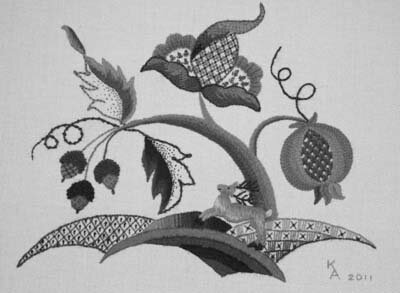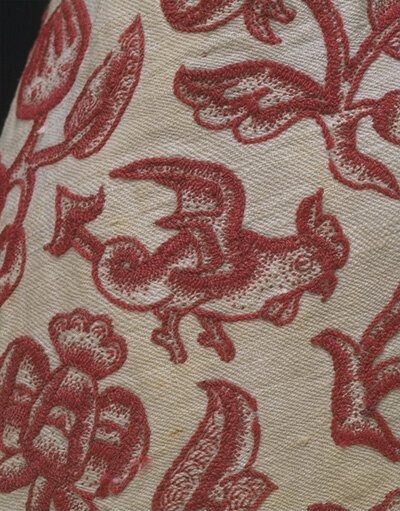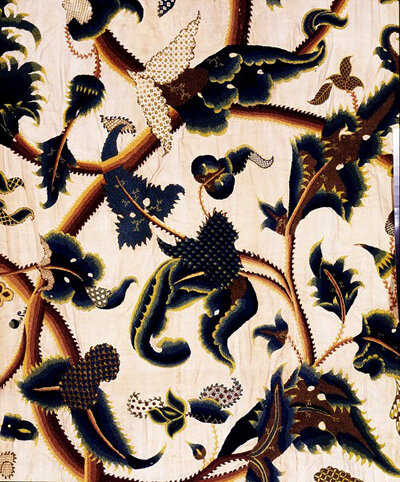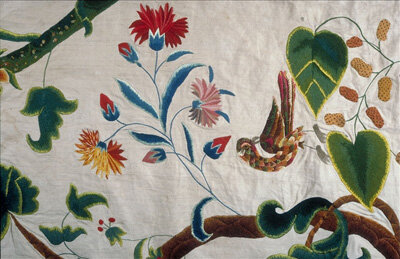RSN Crewelwork Course Day 3 - Color Questions
Color choices are one of the most important decision we make when planning an embroidery piece. Often we like the design in a kit but wish to use different colors. Sometimes we want to add punch to a color palette and want to know what colors will liven up a piece? What are some tips for color choices?Let's begin with changing the colors in a kit or design we like. The first step it to make a black and white photocopy of the picture of the design. This will show you the tonal values of each color.Here's my crewelwork piece in black and white. It shows clearly the difference in the shades of both colors. If I decided, for example, to change the greens to blue and the golden brown to yellows, this would help me to decide where to put the darker blues vs the lighter blues and the darker yellows vs the lighter yellows. Looking at the color wheel below, colors 8 and 18 are close to the colors I used. There are various shades light to dark in each of the colors. To change the colors in the embroidery, I could move around the color wheel to the left 4 places. So the colors that are currently 8 and 18 will become 4 and 14. Naturally I wouldn't go out and buy thread in those two colors and all the lighter or darker shades of those colors without first trying them to see if I liked them together. Taste and personal preference are the most important factors when choosing color for your work. However, this is a good, simple guideline for changing the colors in a piece.
Looking at the color wheel below, colors 8 and 18 are close to the colors I used. There are various shades light to dark in each of the colors. To change the colors in the embroidery, I could move around the color wheel to the left 4 places. So the colors that are currently 8 and 18 will become 4 and 14. Naturally I wouldn't go out and buy thread in those two colors and all the lighter or darker shades of those colors without first trying them to see if I liked them together. Taste and personal preference are the most important factors when choosing color for your work. However, this is a good, simple guideline for changing the colors in a piece. Adding punch to the color palette is another thing many of us wonder how to do effectively. In general the easiest way to find a punchy color is to go directly across the color wheel. These are called complimentary colors.One question was "Are there colors that are considered traditional when doing Jacobean crewelwork?" When looking at old crewelwork pieces you will see reds, blues, greens, golds, browns and oranges. Often when looking at the oldest piece we see rather faded, subdued colors. However, when the back is examined, bright colors are revealed. The colors have become faded through time and exposure to sunlight but would have been bright when they were worked."What is the difference between Jacobean and modern crewelwork in terms of color?" and "Are there rules for choosing color for Jacobean crewelwork?" Obviously, modern work can be done in a wider variety of colors and in colors that weren't available in Jacobean times. Jacobean crewelwork is divided into three time periods: Early, Middle and Late.The early work is in the style of blackwork where only one color of thread is used. A monochrome color scheme of red or blue is very common.
Adding punch to the color palette is another thing many of us wonder how to do effectively. In general the easiest way to find a punchy color is to go directly across the color wheel. These are called complimentary colors.One question was "Are there colors that are considered traditional when doing Jacobean crewelwork?" When looking at old crewelwork pieces you will see reds, blues, greens, golds, browns and oranges. Often when looking at the oldest piece we see rather faded, subdued colors. However, when the back is examined, bright colors are revealed. The colors have become faded through time and exposure to sunlight but would have been bright when they were worked."What is the difference between Jacobean and modern crewelwork in terms of color?" and "Are there rules for choosing color for Jacobean crewelwork?" Obviously, modern work can be done in a wider variety of colors and in colors that weren't available in Jacobean times. Jacobean crewelwork is divided into three time periods: Early, Middle and Late.The early work is in the style of blackwork where only one color of thread is used. A monochrome color scheme of red or blue is very common. Middle Jacobean is done in a bi-chrome color scheme. Two colors including their multiple shades are used. My piece is done in that style.
Middle Jacobean is done in a bi-chrome color scheme. Two colors including their multiple shades are used. My piece is done in that style. Late Jacobean is poly-chrome and uses many different colors. Sometimes the colors are realistically placed and other times realism is completely abandoned making a delightful embroidery.
Late Jacobean is poly-chrome and uses many different colors. Sometimes the colors are realistically placed and other times realism is completely abandoned making a delightful embroidery. One thing that makes all embroidery so beautiful is the personal expression of our color choices. Each embroiderer has a distinctive style of stitching as individual as their handwriting. They also have colors they love and tend to use over and over. So, although there are suggestions concerning color choices, the final decision is yours and should reflect your taste.
One thing that makes all embroidery so beautiful is the personal expression of our color choices. Each embroiderer has a distinctive style of stitching as individual as their handwriting. They also have colors they love and tend to use over and over. So, although there are suggestions concerning color choices, the final decision is yours and should reflect your taste.
